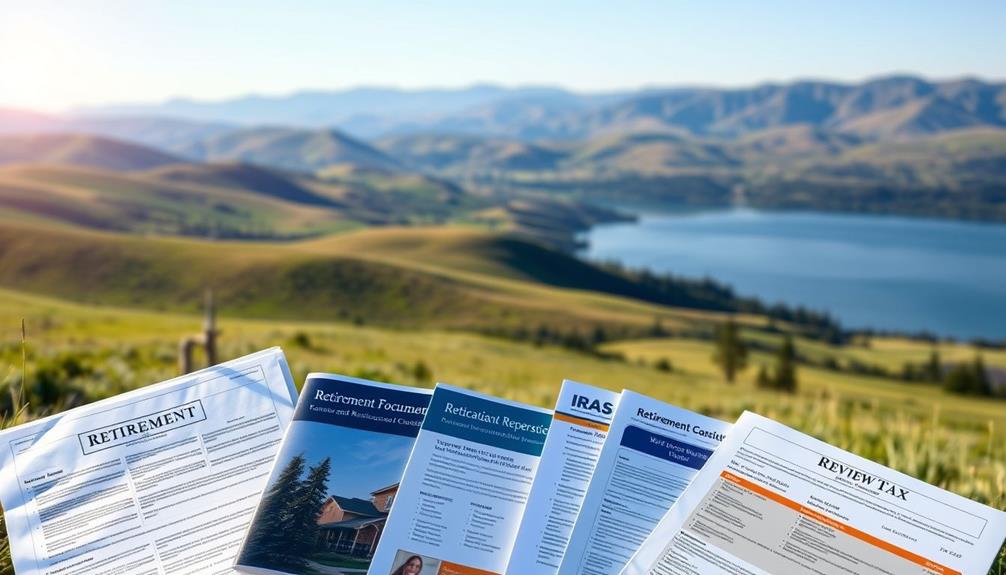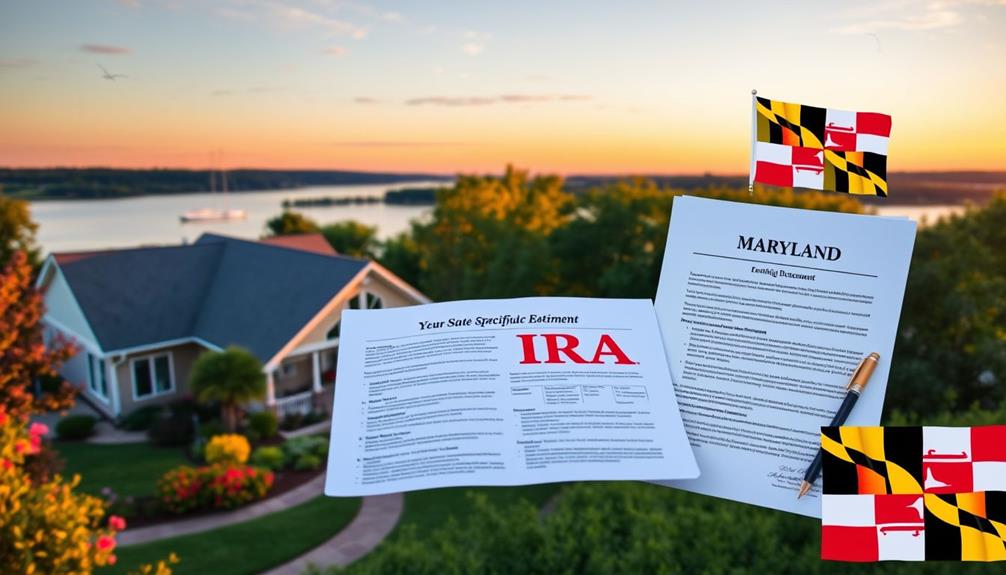To effectively plan your retirement in Montana, integrate your IRAs with state-specific benefits. Maximize your contributions by knowing the limits—$6,500 annually, or $7,500 if you’re 50 or older. Take advantage of Montana’s tax exemptions on certain retirement income, like IRA distributions and military retirement pay. Consider a mix of Roth IRAs for tax-free withdrawals and Traditional IRAs for immediate tax deductions. Don’t forget to evaluate benefits from PERS plans as they provide additional retirement security. Understanding these elements can greatly enhance your retirement strategy, and there’s always more to explore on optimizing your financial plans.
Key Takeaways
- Integrate Traditional and Roth IRAs to balance tax deductions and tax-free growth for retirement savings in Montana.
- Leverage Montana's state tax exemptions for retirement income, including military pay, to maximize overall financial benefits.
- Utilize PERS plans alongside IRAs for predictable income and diverse investment options to enhance retirement security.
- Consider the timing of IRA withdrawals to minimize tax implications and enhance growth potential before retirement.
- Explore tax deductions and credits available for military members and veterans to optimize retirement planning and reduce liabilities.
Understanding IRAs in Montana

When it comes to retirement planning in Montana, understanding Individual Retirement Accounts (IRAs) is essential. IRAs are a popular choice for Montana residents looking to secure their financial future. You can contribute up to $6,500 annually, or $7,500 if you're 50 or older, as of 2023.
Traditional IRAs offer potential tax benefits since contributions may be tax-deductible based on your income and whether you participate in an employer-sponsored plan. This can be a significant advantage when planning your retirement income.
On the other hand, Roth IRAs provide tax-free growth and tax-free withdrawals in retirement, making them especially appealing if you expect to be in a higher tax bracket later. This feature allows you to maximize your retirement savings without worrying about taxation later on.
Moreover, Montana's tax laws exempt certain retirement income, including IRA distributions, from state income tax for eligible residents. This exemption can enhance your retirement planning strategy.
To navigate the complexities of IRAs and their tax implications, you can rely on resources from the Montana Department of Revenue, ensuring you make informed decisions for your retirement.
State-Specific Tax Benefits

As you plan for retirement in Montana, it's vital to understand the state-specific tax benefits that can greatly influence your financial situation.
Montana provides considerable advantages, especially for military members and retirees. For active duty service members, military pay—including combat zone pay—is exempt from state taxes, offering substantial tax relief.
Starting in 2024, eligible residents will also enjoy an exemption on military retirement income, enhancing your financial security.
Additionally, Montana offers a partial exemption on pension and annuity income, which can help reduce your overall tax liability. This can be particularly beneficial as you draw from your retirement accounts.
If you're a nonresident military spouse, you may also find exemptions on income earned in Montana while on military orders, further supporting your family's financial health.
For disabled veterans, Montana has a property tax exemption program that can considerably reduce property tax burdens, sometimes by as much as 100%, depending on income and marital status.
Understanding these state-specific tax benefits is essential for maximizing your retirement benefits in Montana.
Retirement Income Strategies

Effective retirement income strategies in Montana can greatly enhance your financial well-being. By leveraging tax exemptions on military retirement income, you can save considerably, especially since Montana is one of 33 states that exempt this income from taxation.
If you're a veteran, make sure to explore the Montana Disabled Veteran Assistance Program, which offers property tax reductions of 50% to 100%. This can free up more of your resources for essential retirement expenses.
Incorporating Roth IRAs into your retirement planning is another smart move. These accounts allow for tax-free withdrawals during retirement, providing you with greater flexibility and financial security.
Additionally, if you've served in the National Guard or U.S. Armed Forces Reserve, you can deduct travel expenses related to official duties, which can supplement your retirement budgeting.
Montana also offers various resources, including counseling and educational assistance specifically for veterans and service members. These tools can help you optimize your retirement income strategies, ensuring that you make the most of the benefits available to you.
Integration of PERS Plans

When you participate in Montana's Public Employees Retirement System (PERS), you have access to both defined benefit and defined contribution plans.
Understanding the benefits of participation and the available investment options can help you maximize your retirement savings.
Let's explore how to effectively integrate your PERS benefits with your overall retirement strategy.
PERS Plan Overview
Montana's Public Employees Retirement System (PERS) offers a thorough approach to retirement planning, integrating both defined benefit and defined contribution plans to cater to various employee needs.
As a public employee, you'll find that PERS provides a structured way to secure your retirement benefits. Understanding your common financial terms can enhance your decision-making process. The defined benefit plan calculates your future payments based on a formula considering your years of service and average salary, guaranteeing predictable income during retirement.
In addition to the defined benefit plan, PERS also provides defined contribution options, allowing you to actively manage your retirement savings. This flexibility means you can tailor your investments according to your financial goals and risk tolerance.
Both types of plans are funded through a mix of employee contributions, employer contributions, and investment income, helping to maintain the plan's sustainability for the long haul.
Participation in PERS is generally mandatory for eligible public employees, which guarantees that you have access to essential retirement benefits.
The system regularly reviews its funding status and adjusts contribution rates as needed, providing you with transparency and security as you plan for your future.
Benefits of Participation
Participating in the Public Employees Retirement System (PERS) offers you a range of benefits that can greatly enhance your retirement planning. As a state employee, you'll have access to both defined benefit and defined contribution plans, allowing you to select the option that best fits your retirement goals. This flexibility is essential for tailoring your retirement programs.
Contributions to PERS plans come from both you and your employer, ensuring a robust funding mechanism for your retirement benefits. The benefits you receive are calculated based on a formula that considers your years of service and average salary, providing a predictable income stream that can ease your financial worries in retirement.
Moreover, participating in PERS can considerably boost your overall savings plan, particularly when combined with individual retirement accounts (IRAs). This integration diversifies your retirement income sources, offering greater financial security.
PERS keeps you informed with regular updates on funding status and contribution rates, empowering you to make informed decisions about your retirement planning.
Embracing these benefits not only enhances your financial future but also promotes peace of mind as you approach retirement.
Investment Options Available
Accessing a variety of investment options is key for maximizing your retirement savings through the Public Employees Retirement System (PERS). PERS provides both defined benefit and defined contribution plans, allowing you to choose investment options that align with your financial goals. This flexibility can be vital, especially when considering your risk tolerance and retirement timeline.
As a PERS participant, you can diversify your portfolio by allocating funds among various investment vehicles, including target date funds and diversified asset classes. This approach not only helps manage risk but also enhances your potential for growth.
Additionally, PERS offers personalized counseling and retirement planning resources to assist you in making informed investment choices.
Integrating IRAs with your state-sponsored retirement plans can further amplify your retirement savings. By combining these options, you can create a more robust strategy that can potentially increase your overall retirement income.
Whether you're leaning towards a defined benefit plan for its stability or a defined contribution plan for its growth potential, understanding your available investment options is essential for securing your financial future in retirement.
Healthcare Considerations in Retirement

When planning for retirement in Montana, it's important to take into account healthcare costs, which can average over $5,000 annually.
Medicare, available at age 65, covers hospital care and some medical services but doesn't cover all your healthcare expenses. Many retirees find that supplemental insurance plans are necessary to help bridge this gap.
Additionally, long-term care services, which Medicare may not fully cover, can become a considerable financial burden. Considering long-term care insurance is wise to offset these potential costs and make sure you're prepared for the future.
If you're a low-income retiree, Montana's Medicaid program can assist with healthcare costs, but remember, eligibility requirements and asset limits can affect your access to these benefits.
As a result, thorough financial planning is important to maximize your retirement income while managing healthcare expenses.
Ultimately, factoring in potential healthcare costs when estimating your retirement income needs is critical. Ignoring these expenses can greatly impact your overall financial stability, so take the time to assess your options and create a budget that accommodates your healthcare needs in retirement.
Optimizing Withdrawals and Benefits

When planning your retirement withdrawals in Montana, timing is essential to maximize your benefits and minimize tax implications.
Understanding how state benefits, like tax exemptions on military retirement pay and Roth IRA withdrawals, can enhance your financial strategy is key.
Withdrawal Timing Strategies
Optimizing your withdrawal timing from retirement accounts can make a significant difference in your overall financial health during retirement. Implementing effective withdrawal timing strategies can help you minimize tax liability and maximize your retirement benefits.
For instance, consider delaying withdrawals from traditional IRAs until you turn 70, allowing your investments to grow tax-deferred while balancing required minimum distributions (RMDs) later on. Additionally, diversifying your retirement portfolio by incorporating assets like gold through a Gold IRA can protect against inflation and market downturns.
It's also wise to evaluate all your income sources, including Social Security and pensions, before deciding when to withdraw from your IRAs. By doing this, you can strategically align your withdrawals to minimize your overall tax burden and maintain eligibility for state-specific benefits in Montana.
Additionally, utilizing Roth IRAs can be advantageous since withdrawals are tax-free, providing a buffer against future income tax increases.
To navigate these complexities and guarantee you're making the best choices for your unique situation, consulting with a financial advisor is essential. They can help you craft a personalized withdrawal strategy that aligns with Montana's tax laws, guaranteeing you effectively maximize your retirement benefits while minimizing your tax liability.
Tax Implications Overview
Steering through the tax implications of retirement income in Montana can considerably influence your financial strategy. Understanding how different income sources affect your taxable income is essential for effective planning.
Retirement account withdrawals from IRAs or 401(k)s are subject to Montana state income tax, so you'll want to time these withdrawals wisely to minimize your tax liability.
Additionally, while Social Security benefits aren't taxed in Montana, you should also consider other income sources. Montana provides a partial exemption for pension and annuity income, but this is contingent on your federal adjusted gross income. If your AGI exceeds certain thresholds, you could lose some of that tax relief.
Military retired pay is another aspect worth noting, as it's exempt from state income tax for eligible residents, enhancing your financial benefits if you served.
Keeping track of potential deductions, like those for travel expenses related to military duties, can further impact your overall retirement finances. By carefully analyzing these tax implications, you can optimize your withdrawals and benefits, ensuring a smoother shift into retirement in Montana.
Maximizing State Benefits
To make the most of your retirement in Montana, understanding how to optimize your withdrawals and benefits is essential. By leveraging state-specific advantages, you can greatly enhance your financial situation.
| Benefit | Details |
|---|---|
| Military Retirement Pay | Exempt from state income tax, providing substantial savings. |
| Property Tax Reductions | Up to 100% off for eligible veterans through the Disabled Veteran Assistance Program. |
| Roth IRAs | Allow for tax-free withdrawals, boosting your tax efficiency. |
In addition to these benefits, Montana has no estate tax, enabling you to pass assets to your heirs without extra tax burdens. When planning your withdrawals, consider the implications of 401(k) distributions, as state tax rules can affect your overall retirement income.
Frequently Asked Questions
Can You Combine State and Federal Retirement?
Yes, you can combine state and federal retirement accounts. By contributing to both, you enhance your savings strategy. Just be mindful of contribution limits and any specific rules governing each type of account.
What State Has the Best State Retirement Plan?
You'll find California's CalSavers program stands out, mandating automatic enrollment in Roth IRAs. OregonSaves is also strong, promoting employee participation. Both states prioritize retirement savings, making them top contenders for the best state retirement plans.
What Are the Two Government Retirement Plans?
You've got two main government retirement plans: Defined Benefit Plans, which promise a fixed monthly income, and Defined Contribution Plans, where your retirement funds depend on your contributions and investment performance. Choose wisely!
Is a State Retirement Plan an Ira?
A state retirement plan isn't technically an IRA, but it shares similarities in structure and tax treatment. Both aim to help you save for retirement, offering options that can benefit your financial future.
Conclusion
In Montana, integrating your IRAs with state-specific benefits can truly enhance your retirement experience. You might worry that maneuvering these options is too complex, but with the right strategies, it's manageable. Focus on understanding your PERS plans and tax benefits to maximize your income. Remember, planning today means a more secure tomorrow. Embrace the resources available to you and take charge of your retirement—it's worth the effort to guarantee you enjoy the life you've worked hard for.










